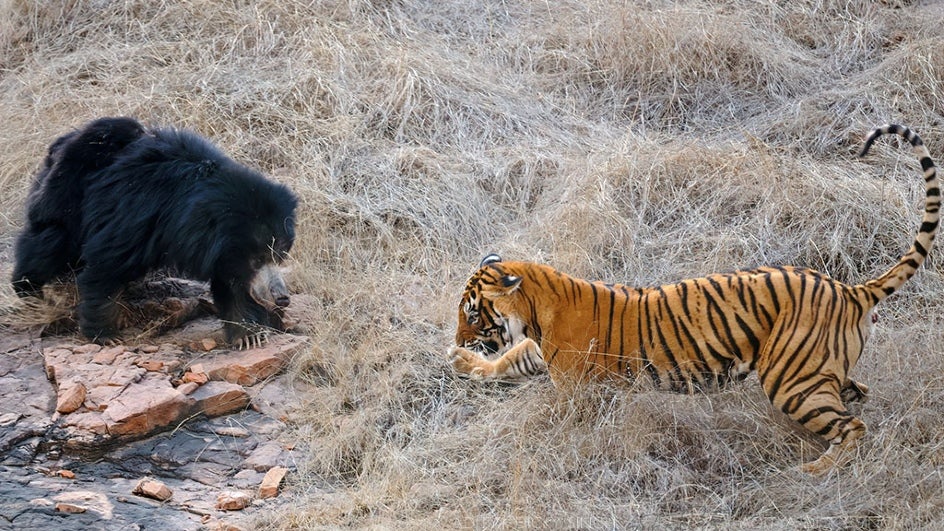Visiting Pench National Park, nestled on the borders of Maharashtra and Madhya Pradesh, reminds us of Rudyard Kipling’s ‘The Jungle Book’. Whether you read the book or watch its movie adaptation, it undoubtedly takes you back to childhood memories, when you gladly enjoyed the roles or dialogues of your favourite characters. Apart from the sole human protagonist Mowgli, there are other characters who are quite close to our hearts Bagheera, the Black Panther, Baloo the Bear and so on. Imagine yourself amidst the jeep safari at Pench, and you spot the real-life ‘Baloo’ in the forest. Won’t it give you the same thrill as spotting a tiger? Yeah, you read that right! The ‘Baloos’ of ‘The Jungle Book’ do exist. The sloth bears.
Did your excitement level double up? If yes, then this blog is for you to know a little bit about your favourite ‘Baloo’, the sloth bears of Pench National Park. Before getting into deeper discussions about the sloth bears, first you should know that the best way to witness the diverse fauna species of the national park is by conducting an Online Pench Safari Booking well in advance.
Meet the real-life Baloo at Pench
The sloth bear, despite its name, is not related to sloths and is far from slow-moving. Contrary to its name, it is an agile bear capable of running faster than a human and can be aggressive if startled. The name "sloth bear" was coined by European zoologist George Shaw, who associated it with tree sloths due to its long claws and distinctive teeth.
This bear's appearance is characterized by long, rough, and unkempt hair around the ears, shoulders, and neck, ranging in colour from cinnamon to dark brown. Exhibiting a white patch on its chest, often forming shapes like Y, O, or U, the sloth bear possesses a pale muzzle and a flexible nose adept at sniffing out scents. Possessing a stocky body and powerful legs, this medium-sized bear is capable of climbing trees, although its inability to retract claws, akin to a cat, gives it a somewhat awkward gait.
The Sloth bear (Melursus ursinus) is categorized as vulnerable on the IUCN Red List, primarily due to habitat loss and degradation. Encroachment by humans into their territories can lead to confrontations, as sloth bears may resort to attacks. Historically, human activities such as hunting for food and the extraction of body parts like bacula and claws have significantly diminished their population. Sloth bears, in addition, have been tamed and employed both as performers and pets.
Life Cycle
Sloth bears exhibit a lifespan of up to 40 years, with females undergoing a gestation period lasting approximately 7 months. Typically, a female sloth bear gives birth to two cubs, although instances of three are rare. The newborns, referred to as cubs, frequently ride on their mother's back. During the initial 2 to 3 months, the cubs remain in the den, receiving maternal care. Offsprings stay close to their mother for the first 2 years of their lives. Remarkably, sloth bear cubs are born blind and gain their sight after about 4 weeks. Notably, male bears do not engage in parental care.
Diet
The sloth bear possesses an adept sense of smell for locating food, although its vision and hearing are not as acute as other bear species. While generally not aggressive, it will stand on its hind legs and employ its teeth and claws for defence against threats like tigers, leopards, and other bears.
Despite its name, the sloth bear shares more similarities with an anteater than with other bears. While omnivorous and consuming fruits when available, it predominantly feeds on termites and ants. To facilitate its insect-rich diet, the bear has sparse hairs on its nose and the ability to open and close its nostrils, preventing bugs from entering while feeding.
Equipped with large, robust 3-inch (8-centimetre) claws, the sloth bear efficiently tears apart termite nests found in soil, old logs, or trees. This process is notably noisy, and sloth bears are recognized for their vocalisations, particularly during meals. A distinct gap between the upper teeth allows for the effective sucking up of termites, creating loud slurping and sucking sounds akin to vacuum cleaners. Additionally, the bears consume a varied diet that includes honey, sugarcane, flowers, eggs, grubs, and carrion.
Characteristics of Sloth Bears
·Sloth bears, primarily nocturnal, occasionally venture out during the day, especially during nursing periods.
· Emitting distinctive grunts and snorts, sloth bears use vocalizations to communicate.
· Proficient climbers, sloth bears exhibit a preference for terrestrial habitats over trees.
· Marking territories with paw marks on trees, sloth bears establish clear boundaries in their environment.
· Displaying heightened aggression in the presence of predators like tigers or leopards, sloth bears adopt a defensive stance, standing on two legs and utilizing front claws for protection.
· While not hibernating, sloth bears experience a period of reduced activity during the rainy season.
· Generally solitary, sloth bears prefer a solitary lifestyle, although adult pairs may temporarily associate during mating seasons.

